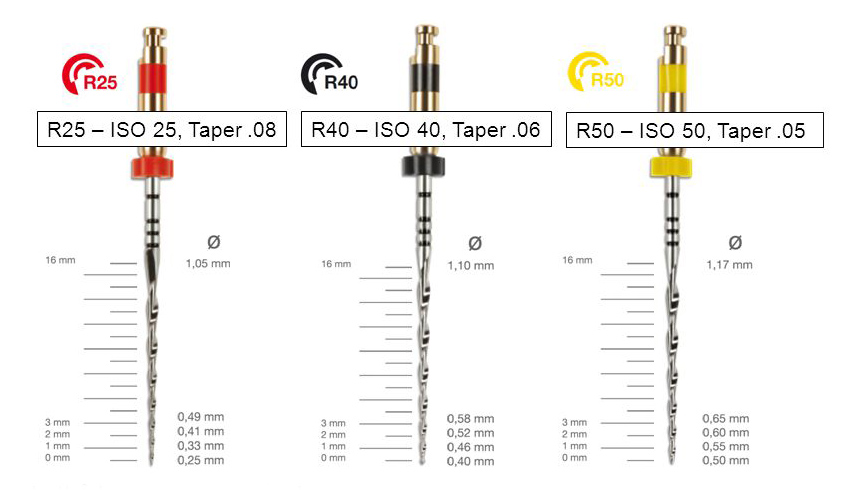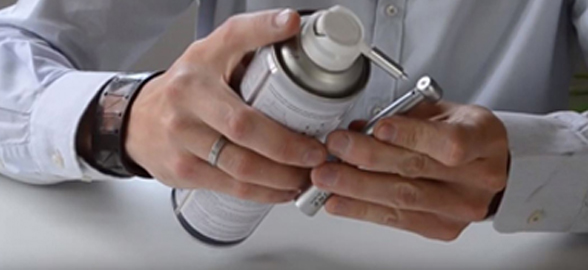The rotary files have revolutionized simplifying endodontic root canal treatment , and limes art is already possible to prepare the entire canal with a single file.
Rotary endodontics is based on a system whereby the traditional manual files have been re-converted, replacing the handle to adapt to low-speed contra angles and endodontic motors with special rotation. With this system, the reciprocal movement that previously only the dentist could perform manually, is possible.
Next we will show you the characteristics of files of the main brands of the sector: Reciproc of the VDW brand and Wave One of the Maillefer brand.
Advantages and characteristics of rotary endodontic files
Reciproc
- Silicone stop The stop, designed in the ISO colour corresponding to the size of the tip of the specific RECIPROC® instrument, facilitates a clear identification of the RECIPROC® instrument, when it is inserted in the contra-angle. The 3 points that represent the 3 movements necessary to complete the 360 ° with reciprocal technique.
- Depth marks . RECIPROC® instruments have depth marks visible on x-rays at 18, 19, 20 and 22 (mm).
- Mandrill The RECIPROC® instruments have a short 11 mm mandrel, which allows better access to the molars, compared to many other instruments whose mandrel is 13 mm or longer.
- The instruments are supplied ready for use , pre-sterilized in blister packs, and simply discarded after use. This allows for a more efficient workflow, eliminates the need to clean and sterilize instruments and significantly reduces the risk of personnel contamination. Cross-contamination between clients is therefore prevented.
Wave One
- WaveOne® works with reciprocal rotation movement, the alternate rotation means that it continuously changes the direction of rotation during the conformation of the conduits.
- A wide angle of rotation in the cutting direction provides high efficiency, while a smaller angle in the opposite direction allows the WaveOne® file to progress safely through the conduit, respecting the anatomy of the same.
- The optimized angles also reduce the risk of screwing and breaking the file.
- The alternating rotation technique allows most of the ducts to be formed using only a WaveOne® nickel titanium file.
- No time is wasted changing the NiTi instruments during the confining of the ducts and the total time of conformation decreases up to 40% compared to the traditional technique of continuous rotation, providing, at the same time, high quality treatments.
Clinical procedure, what files to choose for each type of conduit?
Reciproc
In the case of the Reciproc file range of the VDW brand, it is also made up of three files of different sizes:
- R25 of Red color.
- R40 in Black color.
- R50 of Yellow color.

To find out which file size is preferable to use, consult the preoperative X-ray and see if the root canal is narrow, medium or wide. If the channel visibility is very small, the file to be used would be R25, if the channel is totally visible, it would be necessary to use a file of size 30 and if this one does the work without problem, the type of file to choose would be R50; finally, if the size 30 is not adequate and a smaller one is needed, the appropriate file type would be R40.
Wave One
- Small #021 .06 Yellow.
- Primary #025 .08 Red.
- Large #040 .08 Black.

The file Small is suitable for those occasions in which files of the number 10 are difficult to advance. Whereas if a file of the number 20 works easily and can advance without problems, the file that must be used in the Large . On the other hand, the file Primary is designed for most of the remaining root canals.
Both Maillefer and VDW have a wide range of families with different sizes and types of accessories compatible with their files: Gutta-percha points and Endodontic paper points.
At Dentaltix we have a wide range of endodontic files of the best brands in the sector so that you can choose the one that best suits your needs!






